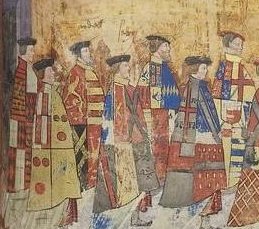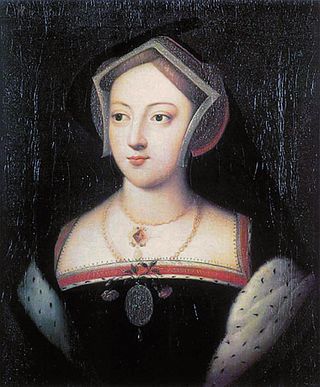
The House of Tudor was an English and Welsh dynasty that held the throne of England from 1485 to 1603. They descended from the Tudors of Penmynydd, a Welsh noble family, and Catherine of Valois. The Tudor monarchs ruled the Kingdom of England and the Lordship of Ireland for 118 years with five monarchs: Henry VII, Henry VIII, Edward VI, Mary I and Elizabeth I. The Tudors succeeded the House of Plantagenet as rulers of the Kingdom of England, and were succeeded by the Scottish House of Stuart. The first Tudor monarch, Henry VII, descended through his mother from the House of Beaufort, a legitimised branch of the English royal House of Lancaster, a cadet house of the Plantagenets. The Tudor family rose to power and started the Tudor period in the wake of the Wars of the Roses (1455–1487), which left the main House of Lancaster extinct in the male line.

Reginald Pole was an English cardinal and the last Catholic Archbishop of Canterbury, holding the office from 1556 to 1558 during the Counter-Reformation.

Margaret Plantagenet, Countess of Salisbury, was the only surviving daughter of George Plantagenet, Duke of Clarence and his wife Isabel Neville. As a result of Margaret's marriage to Richard Pole, she was also known as Margaret Pole. She was one of just two women in 16th-century England to be a peeress in her own right without a husband in the House of Lords.

Philippa Gregory is an English historical novelist who has been publishing since 1987. The best known of her works is The Other Boleyn Girl (2001), which in 2002 won the Romantic Novel of the Year Award from the Romantic Novelists' Association and has been adapted into two films.
Jane Boleyn, Viscountess Rochford was an English noblewoman. Her husband, George Boleyn, Viscount Rochford, was the brother of Anne Boleyn, the second wife of King Henry VIII, and a cousin to King Henry VIII's fifth wife Catherine Howard, making Jane a cousin-in-law. Jane had been a member of the household of Henry's first wife, Catherine of Aragon. It is possible that she played a role in the verdicts against, and subsequent executions of, her husband and Anne Boleyn. She was later a lady-in-waiting to Henry's third and fourth wives, and then to his fifth wife, Catherine Howard, with whom she was executed.

Thomas Howard, 3rd Duke of Norfolk, was a prominent English politician and nobleman of the Tudor era. He was an uncle of two of the wives of King Henry VIII, Anne Boleyn and Catherine Howard, both of whom were beheaded, and played a major role in the machinations affecting these royal marriages. After falling from favour in 1546, he was stripped of his dukedom and imprisoned in the Tower of London, avoiding execution when Henry VIII died on 28 January 1547.

The House of Plantagenet was a royal house which originated from the French county of Anjou. The name Plantagenet is used by modern historians to identify four distinct royal houses: the Angevins, who were also counts of Anjou; the main line of the Plantagenets following the loss of Anjou; and the Houses of Lancaster and York, two of the Plantagenets cadet branches. The family held the English throne from 1154, with the accession of Henry II, until 1485, when Richard III died.

In common parlance, the wives of Henry VIII were the six Queens consort of King Henry VIII of England between 1509 and his death in 1547. In legal terms, Henry had only three wives, because three of his marriages were annulled by the Church of England. He was never granted an annulment by the Pope as he desired, for Catherine of Aragon, his first wife. Annulments declare that a true marriage never took place, unlike a divorce, in which a married couple end their union. Along with his six wives, Henry took several mistresses.
The Exeter Conspiracy in 1538 was a supposed attempt to overthrow Henry VIII, who had taken control of the Church of England away from the Pope, and replace him with Henry Courtenay, 1st Marquess of Exeter, who was a first cousin of the King.
Henry Pole, 1st Baron Montagu, was an English nobleman, the only holder of the title Baron Montagu under its 1514 creation, and one of the relatives whom King Henry VIII of England had executed for treason.

Henry Courtenay, 1st Marquess of Exeter, 2nd Earl of Devon, KG, PC, feudal baron of Okehampton, feudal baron of Plympton, of Tiverton Castle, Okehampton Castle and Colcombe Castle all in Devon, was a grandson of King Edward IV, nephew of the queen consort, Elizabeth of York and a first cousin of King Henry VIII. Henry Courtenay was a close friend of Henry VIII, having "been brought up of a child with his grace in his chamber".

The Boleyn Inheritance is a novel by British author Philippa Gregory which was first published in 2006. It is a direct sequel to her previous novel The Other Boleyn Girl, and one of the additions to her six-part series on the Tudor royals. The novel is told through the first-person narratives of – Anne of Cleves, Katherine Howard, and Jane Boleyn, who was mentioned in The Other Boleyn Girl. It covers a period from 1539 until 1542 and chronicles the fourth and fifth marriages of King Henry VIII of England.

The Tudors is a British-Canadian historical fiction television series set primarily in 16th-century England, created and written by Michael Hirst and produced for the American premium cable television channel Showtime. The series was a collaboration among American, British, and Canadian producers, and was filmed mostly in Ireland. While named after the Tudor dynasty as a whole, it is based specifically upon the reign of King Henry VIII.

Henry VIII is a two-part British television serial produced principally by Granada Television for ITV from 12 to 19 October 2003. It chronicles the life of Henry VIII of England from the disintegration of his first marriage to an aging Spanish princess until his death following a stroke in 1547, by which time he had married for the sixth time. Additional production funding was provided by WGBH Boston, Powercorp and the Australian Broadcasting Corporation.

The Constant Princess is a historical fiction novel by Philippa Gregory, published in 2005. The novel depicts a highly fictionalized version of the life of Catherine of Aragon and her rise to power in England.

Mary Boleyn, also known as Lady Mary, was the sister of English queen consort Anne Boleyn, whose family enjoyed considerable influence during the reign of King Henry VIII.
Sir Edward Neville was an English courtier. He was born at Abergavenny, Monmouthshire. He was the son of George Neville, 4th Baron Bergavenny and his wife Margaret, daughter of Hugh Fenn. He married Eleanor Windsor, daughter of Andrew Windsor, 1st Baron Windsor and Elizabeth Blount, before 6 April 1529. He was the brother of George Nevill, 5th Baron Bergavenny and the two of them became close to King Henry VIII and the Queen, Catherine of Aragon.
Ursula Pole, Baroness Stafford was an English noblewoman; the wife of Henry Stafford, 1st Baron Stafford; a wealthy heiress and the only daughter of Margaret Pole, 8th Countess of Salisbury. Her mother was the last surviving member of the Plantagenet dynasty and was executed for treason at the age of 67 in 1541 by the command of King Henry VIII.

Sir Richard Pole, KG was a supporter and first cousin of King Henry VII of England. He was created a Knight of the Garter and was married to Margaret Plantagenet, a member of the House of York. The marriage reinforced the Tudor alliance between the houses of York and Lancaster.

The mistresses of Henry VIII included many notable women between 1509 and 1536. They have been the subject of biographies, novels and films.















